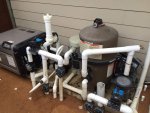Wrapping up our pool project (Austin, TX) and have decided to add in an auto-fill. Didn't want to pay the upgrade initially, but doing some research I've discovered the better option (to me) of plumbing it at the pad. Will likely make it manual at first, but I'm planning to eventually add in a wireless monitor (awesome!).
The issue I'm having is the best place to cut into the lines...?
I've found a few threads here and on other forums that conclude it's best to do it after the pump, which makes sense to avoid pressurizing the inlet side and potentially pushing back on the skimmers. However, beyond that there doesn't seem to be any consensus or recommendations... after/before the filter? The UV/chlorinator? The heater?
To provide some context, I have a pool/spa hybrid with a single heater (automated switchover). Looks something like this:
Inlet : Pump : Filter (large) : UV/Chlorinator : Heater : Return

If you look at the picture you can see a spigot off the Pump -> Filter line that seems like a perfect spot (cut into that close to the spigot end). However it occurred to me that a normal auto-fill wouldn't go through the equipment at all... it would empty into the pool. This seems to imply I should put it after all the equipment (return)? But wouldn't it make to put it forward and "clean/chlorinate" the fill water (city water, already fairly clean) if I can? If I do put it behind the filters, do I put it ahead of the heater? Wouldn't it be advantageous to potentially (colder weather) heat any water I return?
Thanks in advance for any help, not really sure what the implications of different approaches are and if there's a best place to put it.
Rick
The issue I'm having is the best place to cut into the lines...?
I've found a few threads here and on other forums that conclude it's best to do it after the pump, which makes sense to avoid pressurizing the inlet side and potentially pushing back on the skimmers. However, beyond that there doesn't seem to be any consensus or recommendations... after/before the filter? The UV/chlorinator? The heater?
To provide some context, I have a pool/spa hybrid with a single heater (automated switchover). Looks something like this:
Inlet : Pump : Filter (large) : UV/Chlorinator : Heater : Return

If you look at the picture you can see a spigot off the Pump -> Filter line that seems like a perfect spot (cut into that close to the spigot end). However it occurred to me that a normal auto-fill wouldn't go through the equipment at all... it would empty into the pool. This seems to imply I should put it after all the equipment (return)? But wouldn't it make to put it forward and "clean/chlorinate" the fill water (city water, already fairly clean) if I can? If I do put it behind the filters, do I put it ahead of the heater? Wouldn't it be advantageous to potentially (colder weather) heat any water I return?
Thanks in advance for any help, not really sure what the implications of different approaches are and if there's a best place to put it.
Rick


